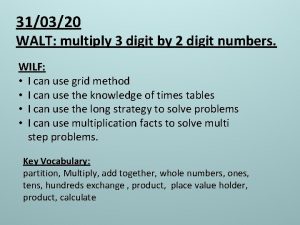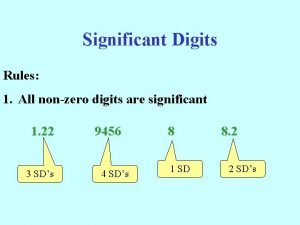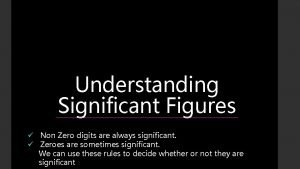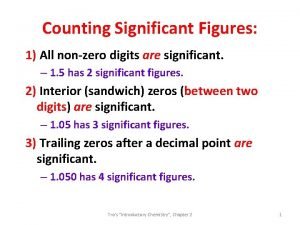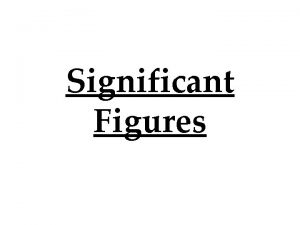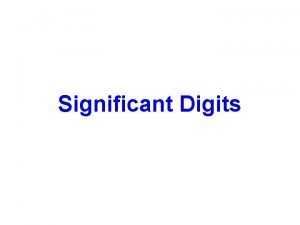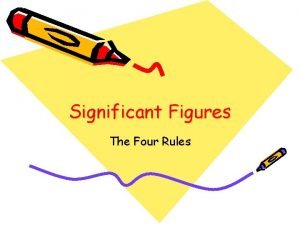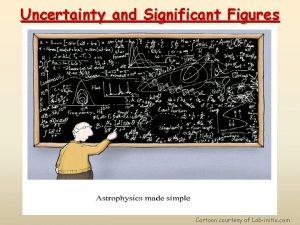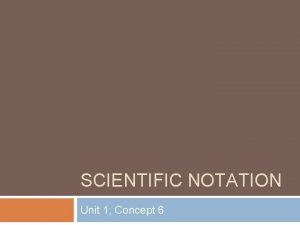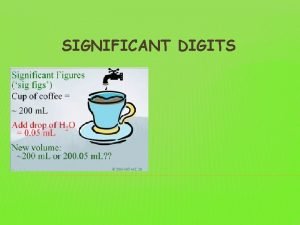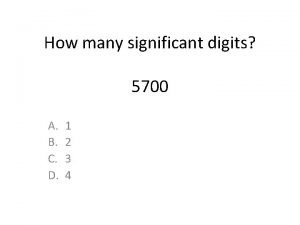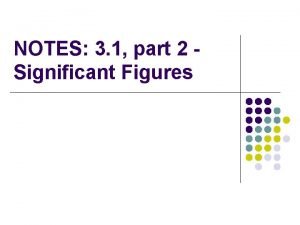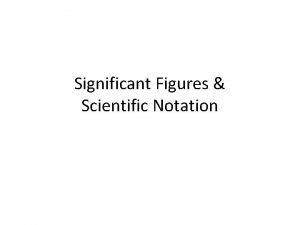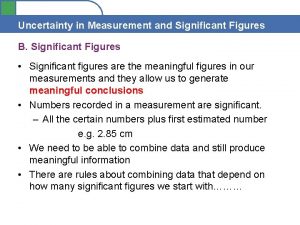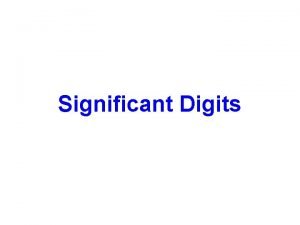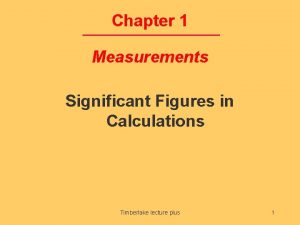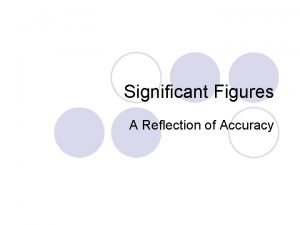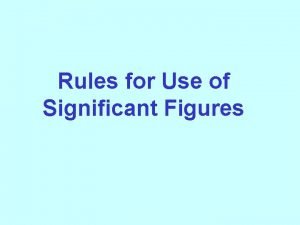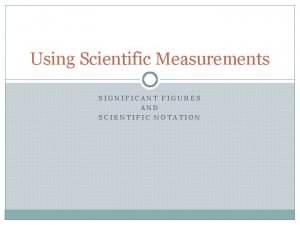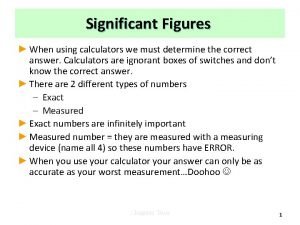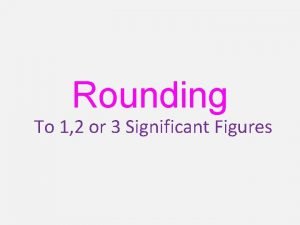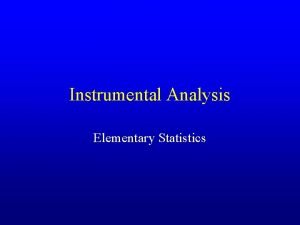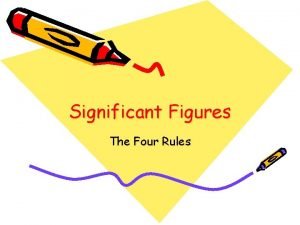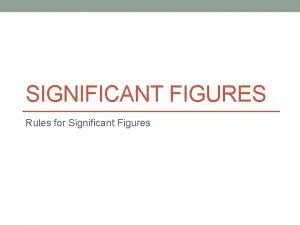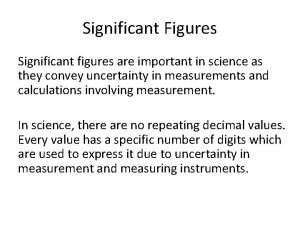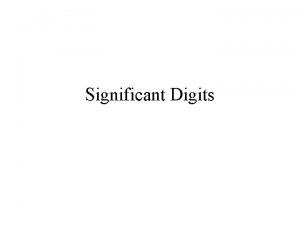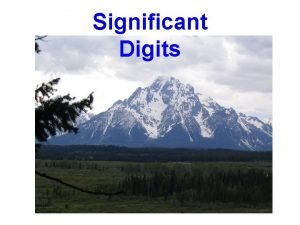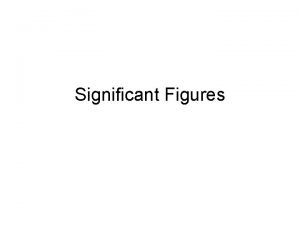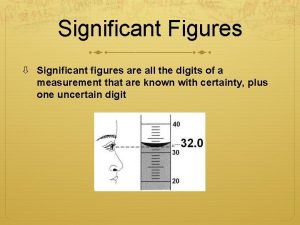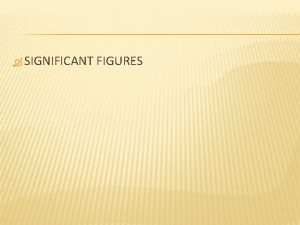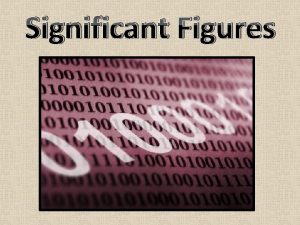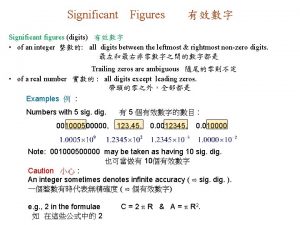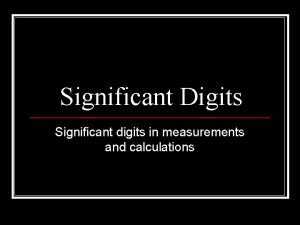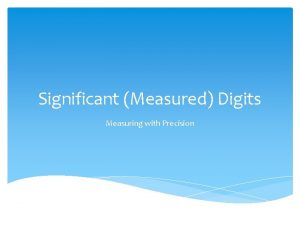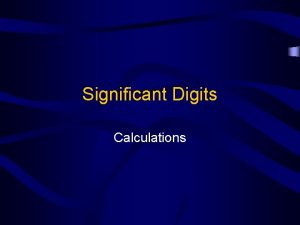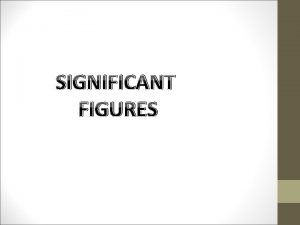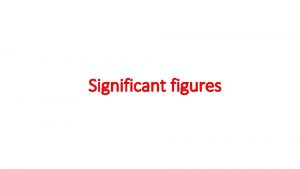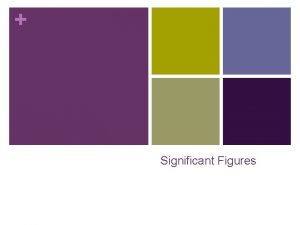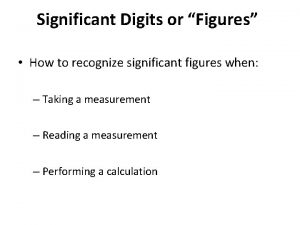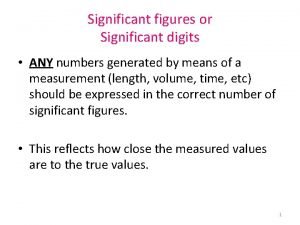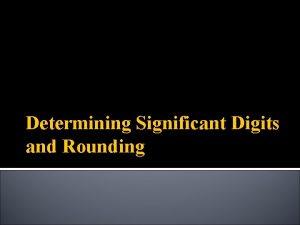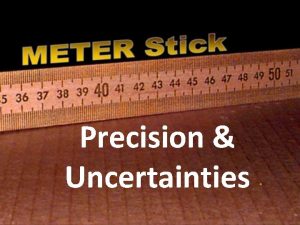Significant Figures Digits Significant figures are all the





































- Slides: 37

Significant Figures (Digits) Significant figures are all the meaningful digits recorded in a measurement (up to and including the uncertainty). uncertainty These meaningful digits tell you about the measuring instrument. If you are not dealing with a measurement, you do not need to think about significant figures! Mathematicians came up with the rules…. . Rationale for Sig. Figs: Mathematically, it does not make sense to add or multiply two measurements of low certainty and obtain a result of higher certainty. . 55 cm x. 55 cm . 3025 cm 2 BECAUSE, YOU CAN’T GAIN MORE CERTAINTY JUST BY MULTIPLYING!

Rules for Counting Significant Figures 1) Non-zero numbers are always significant. 1, 2, 3, 4, 5, 6, 7, 8, 9

2) Leading zeros (zeros that precede any nonzero number) are NEVER significant. 0. 0015 has 2 sig. figs.

3) Captive zeros trapped between two non-zero digits are ALWAYS significant. 10302 has 5 sig. figs. 10. 03 has 4 sig. figs.

4) Trailing zeros (zeros that come after non-zero digits) are significant only if the number has a decimal point. 1200. has 4 sig. figs. (± 1) 1200 has 2 sig. figs. (± 100) 12. 0300 has 6 sig. figs. (±. 0001) 4. 0 has 2 sig. figs. (±. 1)

Exact or Counting Numbers • Numbers not obtained from measuring instruments have infinite sig. figs. • In other words, there is no uncertainty if you don’t use a measuring tool • For example, 25 students • For example, 12, 000 pencils • For example, 10 measurements that you intend to average together

Warmup – 9/17/12 Examples of Counting Sig. Figs: How many sig figs? 1) 30. 052 g 2) 0. 05030 m. L 3) 4500 m 4) 98. 00 cm Which rules?

Rules for Rounding to a Specified Number of Sig. Figs. 1) Start at the left side of the measurement. 2) Start counting at the first sig. fig. (remember that leading zeros are NOT significant) 3) Take how ever many digits you need. 4) Look one more digit to the right. If - equal to or greater than 5, round the previous digit up by one - less than 5, do not round the previous digit up - do not look any farther (no sequential rounding) • Maintain the size or magnitude of the measurement with placeholder zeros if needed! • Ex. Round 45602 m to 2 sig figs • Ex. Round 0. 002305 g to 3 sig figs

Example of Rounding to Sig. Figs. • Round 465. 75 g to: 1 sig. fig. – 2 sig. figs. – 3 sig. figs. – 4 sig. figs. – 5 sig. figs. – Round. 0035461 g to: 1 sig. fig. – 2 sig. figs. – 3 sig. figs. – 4 sig. figs. – 5 sig. figs. -

Q: Why do scientists like scientific notation? • A: It shows the Sig. Figs. !! • Ex) 1. 230 x 106 m has 4 sig. figs. • Ex) 5. 30 x 10 -2 g has 3 sig. figs. • Basically, the digits in front of the “x” sign are your sig. figs!

Unit Conversions do Not Change Significant Figures • Conversion factors have infinite sig. figs too. That means they cannot limit your sig figs. • Ex. Convert: 520. 00 g = ______mg • Ex. Convert: 520. 00 g = ______ kg • Ex. Convert: 14. 40 ft = ______ inches (1 ft = 12 inches)

Warmup • Complete the following table: Measurement Smallest Increment on Tool Uncertainty of the Tool # Sig. Figs. Rounded to (x) Sig. Figs. 0. 0029 g (1) 407. 21 ml (2) 1206 km (1) 1. 0099 mm (4) 705020 m (3) . 219 g (2)

Warmup • Complete the following table: (clicker question #) Measurement Smallest Increment on Tool Uncertainty of the Tool # Sig. Figs. Rounded to (x) Sig. Figs. 0. 0029 g 1 7 13 19 (1) 407. 21 ml 2 8 14 20 (2) 1206 km 3 9 15 21 (1) 1. 0099 mm 4 10 16 22 (4) 705020 m 5 11 17 23 (3) . 219 g 6 12 18 24 (2)

Warmup (key) • Complete the following table: Measurement Smallest Increment on Tool Uncertainty of the Tool # Sig. Figs. Rounded to (x) Sig. Figs. 0. 0029 g . 001 g . 0001 g 2 (1) 0. 003 g 407. 21 ml . 01 ml 5 (2) 410 ml 1206 km 10 km 1 km 4 (1) 1000 km 1. 0099 mm . 001 mm . 0001 mm 5 (4)1. 010 mm 705020 m 100 m 10 m 5 (3) 705000 m . 219 g . 01 g . 001 g 3 (2) 0. 22 g

MATHEMATICAL OPERATIONS WITH Sig. Figs. • “A chain is only as strong as its weakest link!” • Similarly, an answer obtained by calculating with measurements is only as good as the weakest (least certain) measurement!

ADDING AND SUBTRACTING MEASUREMENTS 1. Look at the measurements you are adding/subtracting. Which has the fewest digits to the right of the decimal? 2. Your final answer must have the same number of digits to the right of the decimal.

ADDING AND SUBTRACTING Example 1: 1. 24 m. L + 12. 4 m. L = _____ m. L, but after the correct rounding we get… _____ m. L

ADDING AND SUBTRACTING Example 2: 10. 5 m. L - 5 m. L = ____ m. L, but after the correct rounding we get… ____ m. L

To summarize…. . • With addition or subtraction of measurements, count decimal places!

Practice Set 1 (+ and -) • See part III of your Operations with Sig. Digits. Packet • Do questions a – e. Re-label them as 1 -5. Type your numerical answers into the clickers and send to me. • Pay attention to the correct units for the answer.

MULTIPLYING AND DIVIDING 1. Look at the measurements you are multiplying/dividing. Which has the fewest total number of significant figures? 2. Your final answer must have the same number of significant figures.

MULTIPLYING AND DIVIDING Example 1: 3. 2 cm x 3. 65 cm x 2. 05 cm = ____ cm 3, but after the correct rounding we get… _____ cm 3

MULTIPLYING AND DIVIDING Example 2: 10 cm x 5. 10 cm x 10 cm = _____ cm 3, but after the correct rounding we get… ____ cm 3

To summarize • With multiplication or division of measurments, count total sig. figs!

Practice Set 2 (x and ÷) • See part III of your Operations with Sig. Digits Packet. • Do questions f-i. Re-label them as 1 -4. Type your numerical answers into the clickers and send to me. • Pay attention to the correct derived units for the answer.

SUMMARY For adding/subtracting, count decimal places. For multiplying/dividing, count total significant figures.

Combining Operations • If a problem contains all addition/subtraction, or all multiplication/division, you will only round to sig. figs. once at the end of the problem using the appropriate rule. • However, if a problem has addition/subtraction mixed with multiplication/division, you must round to sig. figs for each part individually. • Round the least number of times possible! Over-rounding will cause your answer to stray away from the true value. • Ex. (4. 500 g + 2. 41 g) / (15. 5 m. L – 3. 2 m. L) • Ex. (. 35 kg +. 127 kg)(4. 3 m – 3. 42 m) / (9. 0 s – 2. 1 s)

Averaging Measurements • Ex. (3. 342 g + 3. 52 g + 3. 32 g) / 3 = 10. 182 g / 3 = 3. 394 g 3. 39 g • Remember, the “ 3” stands for “ 3 measurements” and is therefore an exact or counting number with infinite sig. figs. It is not a measurement. • So, the only sig. figs rule you will apply is the addition/subtraction rule. Therefore, the answer should have 2 decimal places.

Warmup 1) Perform the following calculation and round to sig. figs: (56. 02 g + 4. 135 g) / [(33. 20 cm)(2. 25 cm)(0. 19 cm)] 2) Let's round off 60, 495 kg to: (a) 1 sig. fig. (b) 2 sig. figs. (c) 3 sig. figs. (d) 4 sig. figs. (e) 5 sig. figs.

Warmup 1) Perform the following calculation and round to sig. figs: (56. 02 g + 4. 135 g) / [(33. 20 cm)(2. 25 cm)(0. 19 cm)] 2) Let's round off 60, 495 kg to: (a) 1 sig. fig. (b) 2 sig. figs. (c) 3 sig. figs. (d) 4 sig. figs. (e) 5 sig. figs.

Practice Set 3 (Combining Operations) • See part III of your Operations with Sig. Digits Packet. • Do questions j-m. Re-label them as 1 -4. Type your numerical answers into the clickers and send to me. • Pay attention to the correct derived units for the answer.

FINDING THE VOLUME OF A SOLID METHOD 1: Using a formula (regular solids). Volume of a rectangular solid = (l)(w)(h)

FINDING THE VOLUME OF A SOLID METHOD 1: Using a formula (regular solids). Volume of a sphere =4/3 r 3 =4/3 (d/2)3

FINDING THE VOLUME OF A SOLID METHOD 1: Using a formula (regular solids). Volume of cylinder =h r 2 =h (d/2)2

FINDING THE VOLUME OF A SOLID METHOD 2: Using the displacement technique (great for irregular solids). Volume of solid = Final volume – Initial volume

WARMUP 1. Calculate the volume of the Earth (assuming it is a perfect sphere). The diameter is 12756. 2 km. E: V = 4/3 (d/2)3 S: S: U: 2. Average the following measurements and express the answer to significant digits: 3. 1 g/m. L, 2. 99 g/ml, 3. 015 g/ml, 3 g/m. L

WARMUP 1. Calculate the volume of the Earth (assuming it is a perfect sphere). The diameter is 12756. 2 km. E: S: S: U: 2. Average the following measurements and express the answer to significant digits: 3. 1 g/m. L, 2. 99 g/ml, 3. 015 g/ml, 3 g/m. L
 Insidan region jh
Insidan region jh How to multiply 3-digit numbers by 2-digit numbers
How to multiply 3-digit numbers by 2-digit numbers All nonzero digits are significant.
All nonzero digits are significant. Round 5 239 to 2 significant figures
Round 5 239 to 2 significant figures Chemistry sig figs
Chemistry sig figs All non zero digits are
All non zero digits are When is zero a significant figure
When is zero a significant figure Significant number
Significant number How many significant figures are in: 450. 820
How many significant figures are in: 450. 820 Sigfigs
Sigfigs Significant digits and measurement pogil
Significant digits and measurement pogil Significant numbers rules
Significant numbers rules Three significant digits
Three significant digits In 5700 m significant digits are
In 5700 m significant digits are Sig fig
Sig fig Significant figures
Significant figures Significant digits
Significant digits Significant figures cartoon
Significant figures cartoon English to metric conversion table
English to metric conversion table Name 3 points
Name 3 points What is a significant figure in chemistry
What is a significant figure in chemistry When is 0 a significant figure
When is 0 a significant figure Learning significant figures
Learning significant figures Significant
Significant Reflection about significant figures
Reflection about significant figures Sig figs rules
Sig figs rules Significant figures of whole numbers
Significant figures of whole numbers Significant figures rules
Significant figures rules How many significant figures are in the number 750.?
How many significant figures are in the number 750.? Round to 3sf
Round to 3sf Significant figures sentences
Significant figures sentences Significant figures made easy
Significant figures made easy Significant figures statistics
Significant figures statistics Number rule
Number rule Significant figures games
Significant figures games Sig figs rules
Sig figs rules Rules for significant figures class 11
Rules for significant figures class 11 91010 significant figures
91010 significant figures

